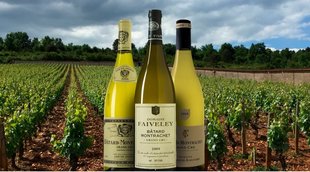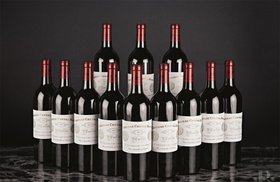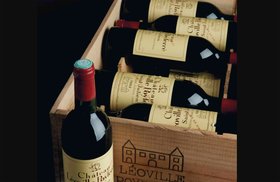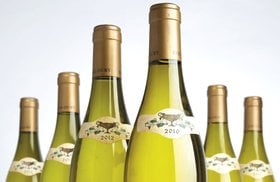Montrachet Wine (Best Wines, Prices & How to Buy)
Looking to buy a Montrachet wine to add to your wine collection?
The Montrachet region produces some of the finest Chardonnay wines in the world, including the famous DRC Montrachet Grand Cru and the Domaine Leflaive Batard Montrachet.
But, where is the Montrachet Wine Region? Which are the wines made there, and what’s unique about each of them?
More importantly: how do you buy a Montrachet wine?
In this article, we’ll walk you through the Montrachet wine region and its unique terroir (environmental factors.) We’ll also show you the best wines from this appellation and the easiest way to buy them for drinking and investing.
Further reading
- Discover The Best Wine Brands In The World In 2021.
- Also find out more about French Wines.
- Explore the scenic wine region of Chateauneuf du Pape and its best wines.
The Montrachet Wine Region
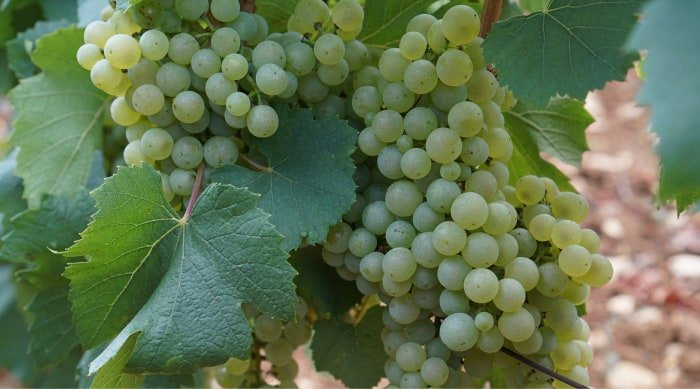
The renowned French wine region of Burgundy (Bourgogne in French) has five primary wine growing areas:
- Chablis
- Côte de Nuits
- Côte de Beaune
- Côte Chalonnaise
- Mâconnais
Montrachet is the oldest of the five Grand Cru appellations of Côte de Beaune. It’s also the second largest of the five sites, covering about eight hectares of land. (The other four Grand Crus are Bâtard-Montrachet, Chevalier-Montrachet, Bienvenues-Bâtard-Montrachet, and Criots-Bâtards-Montrachet.)
The Grand Cru vineyard lies between Meursault in the North and Santenay in the South.
Located midslope on Montrachet hill, the vineyard lies above the villages of Puligny-Montrachet and Chassagne-Montrachet. It covers land in both the Puligny-Montrachet and Chassagne-Montrachet communes.
Interestingly, the way the vines are planted makes the divide visible. The vines on the Puligny side (known as Montrachet) run from east to west. On the Chassagne side (commonly known as Le Montrachet), the vines generally follow a north to south orientation.
A Brief History of the Montrachet Appellation
Winemaking in Montrachet can be traced back to the Middle Ages! In 1252, local landowners donated parcels of vines to the Cistercian church of Maizières in the ‘Montrachaz’ area.
For many years Montrachet was just a stoney vineyard with none of the borders that it now has. In 1879, both the villages of Puligny and Chassagne appended the name ‘Montrachet’ to their names. And in July 1937, Montrachet was made an appellation.
Today, the Montrachet vineyard is split into sections or plots, each owned by a different producer - each producing some of the world’s most coveted white wines. They are:
A. Plots in Puligny-Montrachet (Montrachet):
- Marquis De Laguiche Jean
- Maison Bouchard Pere et Fils
- Mm Ramonet Noël et Jean-Claude
- Guillaume
- Guillaume (Boillerault de Chauvigny)
- Regnault de Beaucaron
- Mme De Surville
- Le Cailleret 1er Cru de Puligny-Montrachet
- Clos de la Mouchère Premier Cru vineyard
B. Plots in Chassagne-Montrachet (Le Montrachet):
- Ch. de Puligny Montrachet
- Domaine de la Romanée-Conti
- Domaine des Comtes Lafon
- Domaine Jacques Prieur
- Domaine Leflaive
- Domaine Thénard
- M Amiot Guy et Mme Monnot Jean-Claude
- M Colin Marc
- Mlle Petitjean Claudine
- Mme Blain-Gagnard Claudine
- Mme Fontaine-Gagnard Laurence
- Mr. Fleurot René
The Four Surrounding Montrachet Grand Crus
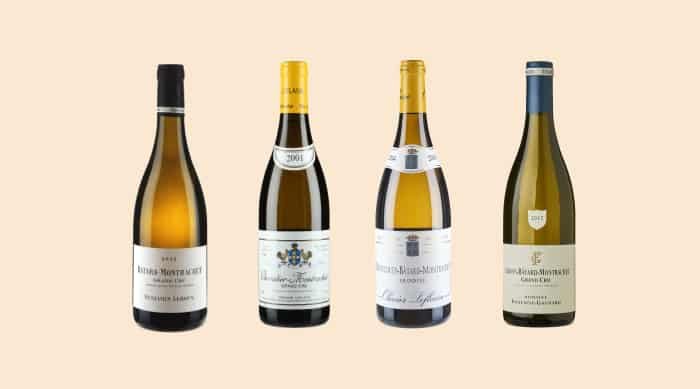
Montrachet may be the oldest, and possibly the most prestigious of the five vineyards in Côte de Beaune. But the other four Grand Crus that surround it hold their own in terms of wine quality.
Let’s see what they are.
A. Batard-Montrachet
Batard-Montrachet is a Grand Cru that also covers land in Chassagne-Montrachet and Puligny-Montrachet. Its terroir is ideal for the Chardonnay grape varietal that makes complex wines with excellent aging potential like the Corton Charlemagne and the Etienne Sauzet Batard-Montrachet Grand Cru.
Some famous winemakers in this Grand Cru include Domaine Bachelet-Monnot and Girardin.
B. Chevalier Montrachet
The Chevalier-Montrachet Grand Cru appellation lies entirely within Puligny. It produces the most concentrated white Burgundies with layered richness.
Wines produced in Chevalier-Montrachet are similar in style to Montrachet wines and tend to become more complex as they age.
Bouchard Pere et Fils and Domaine Colin-Deleger are some of the popular wine producers found here.
C. Bienvenues-Batard-Montrachet
This is a small Grand Cru vineyard that lies entirely within Puligny-Montrachet. Many of the Bienvenues wines are comparable to those from Bâtard-Montrachet.
Popular wine producers in Bienvenues include Domaine Louis Carillon et Fils and Domaine Paul Pernot.
D. Criots-Batard-Montrachet
This small Grand Cru vineyard sits entirely within Chassagne-Montrachet and makes some of the greatest white wine vintages. At 3.9 acres (1.5 hectare) it is one of the smallest Grand Cru vineyards in France, producing less than 400 cases of wine a year.
Wine producers here include Domaine d'Auvenay and Domaine Fontaine-Gagnard.
Now, let’s look at what’s unique about the environmental factors (terroir) in Montrachet.
Montrachet Terroir and Viticulture

Montrachet lies on a natural, even slope, around 840ft (256m) above sea level. The underlying rocks date from the Jurassic (175 million years BC).
Another unique factor in the Montrachet terroir is that the soil contains manganese, which is absent in Chevalier-Montrachet or Batard-Montrachet.
The entire Montrachet area is sheltered by the three-way hills surrounding the area, giving it the best temperature, rainfall and wind conditions of all Burgundy.
The vines are angled southeast, exposing them to the sunshine that’s essential to the ripening process. The slope of the vineyard with its stony limestone soil allows for excellent drainage. The vines grow deep, healthy roots into the limestone to access the water and minerals there.
The limestone soil also helps to reflect the light up to the vine canopy, which allows the grapes to reach optimal ripeness. Most of the vineyards use organic and traditional methods to cultivate the vines - such as using horses instead of tractors to prevent compacting the soil.
Let’s move onto the wines made in this region.
Montrachet Wines
Montrachet wines are all of the white variety, made from 100% Chardonnay grapes. The region produces some of the world’s best Chardonnay wines. These dry white wines are noted for their richness and structure, and a bottle can cost from $170 to $2900 dollars, with rarer vintages priced even higher.
Many Montrachet wines are made in limited amounts - Domaine Leflaive’s Montrachet Grand Cru wines are a good example. Another example is Lucien Le Moine wine, which becomes instantly collectible upon release. The Montrachet DRC Domaine makes only two barrels of its Batard Montrachet Grand Cru a year.
How is a Montrachet wine made?
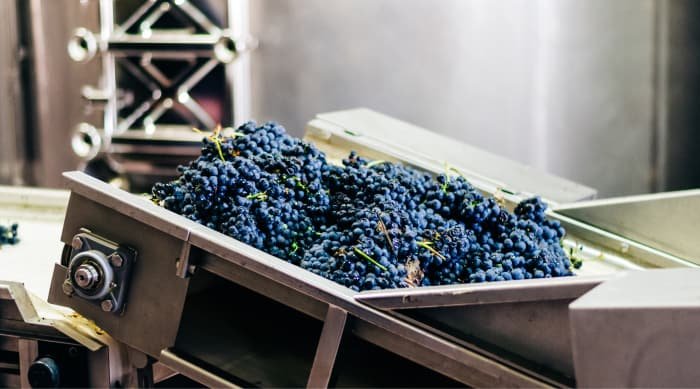
Every winemaker in Montrachet has adopted its own special winemaking methods. But the general steps in the process are similar.
As an example, let’s look at producer Joseph Drouhin’s wine making practices in the Montrachet Marquis de Laguiche Grand Cru estate:
The estate of Marquis de Laguiche is located on the Puligny side of the appellation. It has a very mild slope and excellent south-east exposure. The plantation density is 10,000 stocks per hectare - this helps in extracting as much nuance from the terroir as possible.
How is the vinification done?
The grape varietal is harvested by hand - in small open crates - to preserve the integrity of the fruit.
They are then sorted. Sometimes, the grapes are sorted twice — once when being picked, the second time on the sorting table at the winery.
Pressing is done very slowly. Juices from the last pressings aren’t used. The wine goes directly into barrels for fermentation after débourbage (decanting of white wine to minimize sediment).
The wines are aged in oak barrels for 15 to 18 months - the wood of which is weathered for three years before use.
Now, which are the great wine producers in Montrachet whose wines you should get hold of?
Best Montrachet Wines
We’ve handpicked some of the best wines of the region.
1. Domaine Leflaive Montrachet Grand Cru, Cote de Beaune
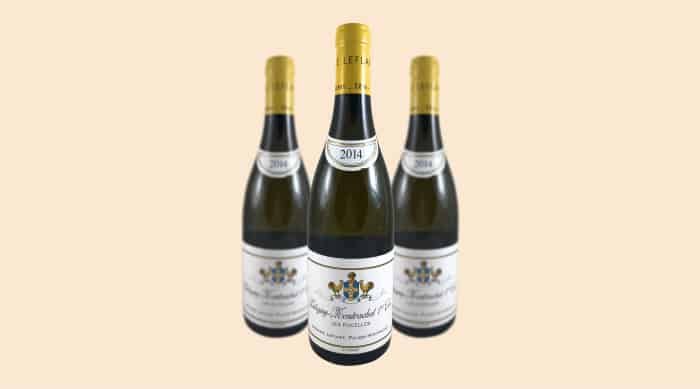
Domaine Leflaive is based in Puligny-Montrachet, and is one of the most significant producers in the Côte de Beaune.
Here’s an interesting fact: Joseph Leflaive is the winemaker who acquired the 1er Cru and Grands Crus in the area to start winemaking in Domaine Leflaive. But, his son - Olivier Leflaive - left the Domaine in 1995 to focus on his new venture, Maison Olivier Leflaive.
This Domaine makes four grand cru wines and four premier cru wines in Puligny-Montrachet. It focuses almost entirely on white wines made from Chardonnay. The Montrachet Grand Cru is, arguably, Leflaive’s greatest dry white wine.
Taste: The 2014 vintage is vibrant and has a nice minerality. It is solid and sweet but with strong lemony acidity. You’ll love the aromas of apricot, peach, iodine and grilled, and smoky oak.
Aging potential: 8+ years.
Serve with: Pasta, rich fish, mild and soft cheese.
Average price: $10,000+
2. Domaine de la Romanee-Conti Montrachet Grand Cru, Cote de Beaune

The prestigious Domaine de la Romanée-Conti owns a small plot of land in Montrachet. It is co-owned by the de Villaine and Leroy/Roch families. Today, the Domaine is run by Aubert de Villaine and Henri-Frederic Roch.
In Burgundy, this Domaine is commonly referred to as “DRC” or "the Domaine". DRC produces mainly red wine, with their single white wine variety being made in Montrachet.
Taste: The 2009 vintage is an aromatic wine with the aroma of honey, ripe pineapple, menthol, spearmint, vanilla, caramel and wild herbs.
Aging potential: 8-20 years. The 2009 vintage is ready to drink but will improve in taste and complexity at least until 2030.
Serve with: Salmon with a mild butter sauce, lobster, crawfish.
Average price: $8,000+
3. Domaine Ramonet Montrachet Grand Cru, Cote de Beaune

Domaine Ramonet is a wine producer in the Burgundy appellations of Chassagne-Montrachet and Puligny-Montrachet. Old vines and low yields form the basis of Ramonet's viticulture. Vines that are younger than 18 years are not used in the top cuvées.
Taste: The 2011 vintage is balanced, full-bodied and well-structured. It is creamy, layered with the flavor of honey, truffles, spice, tropical fruits, glycerin and herbs.
Aging potential: 15+ years. The 2011 vintage will improve in taste as it matures up to 2060.
Serve with: Salads.
Average price: $2800+
4. Domaine des Comtes Lafon Montrachet Grand Cru, Cote de Beaune

Domaine des Comtes Lafon is a Burgundy wine producer who makes some of the most acclaimed Chardonnay in the region. In 1995, the Comtes Lafon adopted organic practices and has adopted biodynamic farming since 1988. Its most eminent wine is the Domaine des Comtes Lafon Grand Cru Montrachet.
Taste: The 2010 vintage has the aroma of citrus and hazelnuts oils, white peach, verbena creamed Cavaillon melon and glazed pear flavors.
Aging potential: 15+ years. The 2010 vintage is ready to drink but will continue to improve in complexity until 2043.
Serve with: Salmon with mushroom sauce.
Average price: $2,100+
5. Bouchard Pere et Fils Montrachet Grand Cru

Bouchard Pere et Fils is a historic Burgundy wine estate, founded in 1731 - the largest vineyard owner in Côte d'Or.
It makes over 100 wines mostly from Pinot Noir or Chardonnay, in appellations that include the Maconnais, Côte Chalonnaise and Beaujolais régions.
The wines are matured in oak, in a cellar at the 15th century Château de Beaune. This cellar excavated directly into the earth, giving it optimum temperature and ventilation.
Taste: The 2015 vintage is full-bodied, concentrated with superb balance. You’ll love the aromas of buttered apples, popcorn, mandarin rind, peach pit, a floral bouquet of orange blossom, and a hint of new oak.
Aging potential: 8+ years. The 2015 vintage is ready for drinking but will improve in taste and character until 2030.
Serve with: Scallops.
Average price: $600+
6. Joseph Drouhin Marquis de Laguiche Montrachet Grand Cru, Cote de Beaune

Joseph Drouhin is one of Burgundy's most important wine producers. Founded in Beaune in 1880, the Domaine has expanded throughout the 20th Century and has vineyards in Chablis, the Côte de Nuits, the Côte de Beaune and the Côte Chalonnaise.
Domaine Joseph Drouhin produces several grand cru wines in the Côte d'Or and Chablis, including the Marquis de Laguiche Montrachet Grand Cru.
Taste: The 2010 vintage is a focused, balanced, concentrated and full-bodied wine. On the palate it offers vanilla, plum, honey, truffles, smokey and buttery flavors.
Aging potential: 8+ years. The 2010 vintage is ready to drink but has the potential to age beautifully until 2023.
Serve with: Red tuna tartare.
Average price: $700+
Now, for the most important question in your mind:
How Can You Buy Montrachet Wines?
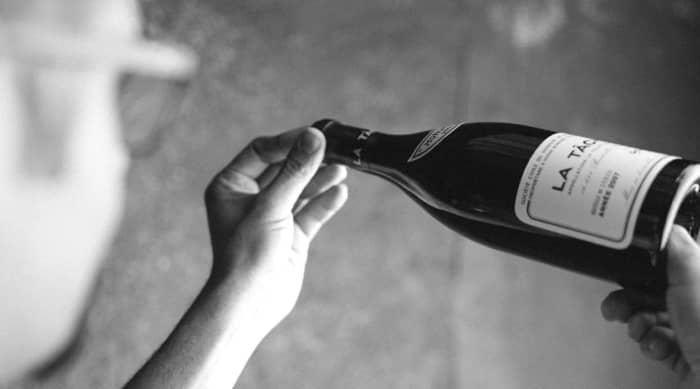
Most Montrachet wines are considered luxury wines with a high pedigree - hence are expensive and highly sought after.
There are a number of channels you can go through to get hold of these exclusive wines - each with their own challenges.
A. Visit wineries in Chassagne-Montrachet and Puligny-Montrachet
You can experience some of the best Montrachet Grand Crus and Premier Crus in the estates in Chassagne-Montrachet or Puligny-Montrachet. Head to Domaines Famille Picard or Maison Leflaive Olivier La Maison Hotel et Restaurant for wine tasting.
B. Buy from online wine merchants
You can buy Montrachet wines from online wine merchants. Each seller may offer you a different price - so you’ll have to do a thorough market comparison to ensure you’re getting the best deal on the vintage you want.
You’ll also have to be careful of counterfeit wines. Pick a trustworthy retailer who will authenticate your bottle of wine.
C. Go through a wine broker
If you’re not interested in the DIY research and wine buying route, you could always rope in wine brokers.
Wine brokers specialize in buying and selling wines, and will help authenticate the wine for you. They usually have insider knowledge of exclusive wine deals. This is great for a fine wine collector, as some wines aren’t listed on most online platforms due to limited availability.
But, the downside is that you’ll have to pay hefty commissions and fees on each purchase.
D. Find it on a wine exchange
Wine exchanges are peer-to-peer online marketplaces. Its members trade wine from all over the world with private individuals, wine funds or syndicate groups. You’d be skipping the merchants, brokers, and auction house if you chose to go via a wine exchange.
However, you’ll have to do your own research on wines to value the wines you’re interested in. So, this might not be the best option for someone new to collecting or investing in wines.
As you can see, each of these avenues to buy Montrachet or any other wines comes with its own challenges. Also, it's not easy to get hold of some of the rare wines unless you’re an industry insider!
Your best option would be to entrust a wine investment company like Vinovest to handpick and buy the best Montrachet wines for you, at the best prices.
You won’t have to worry about storing the precious bottles, and even selling them to make a profit!
Curious to know how?
Read on.
Buy Montrachet and Other Collectible Wines Through Vinovest

Vinovest is an online wine investment platform that not only lets you buy wines for drinking but also for investing in the long term. Vinovest helps you choose, authenticate, buy, store and sell your wines.
How does it work?
The process is incredibly simple. There are only four steps for you to go through:
- Sign up on the Vinovest website.
- Fill up a questionnaire for Vinovest to assess your investment preferences and risk appetite.
- Add funds to your account (a minimum of $1,000).
- Track your fine wine portfolio online.
Benefits
Here’s why you should buy, store, and sell your wines through Vinovest.
Easy Buying and Selling
Vinovest’s Artificial Intelligence (AI)-based online platform helps you buy and sell wines easily. You can add any coveted wine from anywhere in the world easily to your portfolio.
Provenance and authenticity
Vinovest authenticates every single bottle and traces its provenance before you buy them. This way, you won't have to worry about counterfeit bottles.
Curated portfolio of Montrachet and other wines
Vinovest has an expert team of Sommeliers and data scientists to curate your portfolio with proprietary financial models that use historical data. You can access your wine online at any time.
Low Fees
On top of adding funds to your account, you’ll need to pay a 2.5% annual fee (or 1.9% for a portfolio above $50,000). This covers wine purchases, authentication, storage, a full insurance policy at market value, portfolio management, and selling your bottles. You’ll also enjoy tax advantages as bonded warehouses don’t charge VAT and excise duty.
Optimal Storage
Your wine bottles are stored safely in bonded warehouses, under perfect conditions of light, humidity, vibration, and temperature.
Insurance
Vinovest ensures that your wines are safe under the eyes of security cameras 24/7. Power back-ups guarantee the perfect climate control in case the primary method fails. There’s also a comprehensive insurance policy to protect your wine cellar.
Ownership
You own every single wine you buy through Vinovest.
Easy Delivery
Once sold, Vinovest will deliver your wines to your buyer, safely. But if you wish to drink your buttery Montrachet, you can always have it delivered to your home.
To conclude:
The luxurious Montrachet wines make the perfect addition to your wine cellar at home and to your wine investment portfolio!
You’ll be able to buy this white Burgundy wine in many ways, including online portals. But you’ll have to fret over hours of market research, finding an authentic bottle at the right prices, high broker commissions, and the hassles of storing them safely in your cellar.
Your best best would be to work with the expert wine investment team at Vinovest to buy your Montrachet, Louis Jadot or Louis Latour wines!
So, how about signing up right away and start building your wine portfolio?
